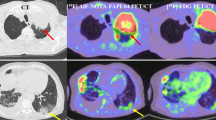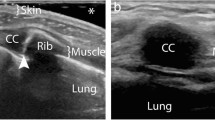Abstract
Purpose
This study was performed to determine the type and incidence of complications of fine-needle aspiration biopsy (FNAB) and core biopsy (CNB) performed under computed tomography (CT) guidance to characterise lung lesions, and assess the diagnostic accuracy of the two techniques.
Materials and methods
In 2009–2011, we performed 124 lung biopsies (66 CNB and 56 FNAB) on 121 patients with a mean age of 72.4 years. Exclusion criteria were pulmonary resection, pleural lesions and/or effusions, and inadequate blood-coagulation profile. All examinations were acquired after contrast-agent administration in a craniocaudal direction from the lung apex to base during a single inspiratory breath-hold, with standardised parameters. Each lesion was scanned with 13–15 slices that could be repeated whenever necessary to document the needle track and for lesion centring, by positioning a metallic marker perpendicular to the centring light to indicate the point of needle access. Unless otherwise clinically indicated, 4 h after the procedure chest radiography was performed.
Results
Age was found to be a factor influencing the complications: pneumothorax in young subjects (31 %) and parenchymal haemorrhage in the elderly (30 %), with CNB but not with FNAB. We had more complications with the right lung: 50 % of pneumothorax cases in the upper lobe with CNB and 40 % of cases of haemorrhage in the lower lobe with FNAB. The anterior approach gave rise to more complications with CNB, while the posterior approach with FNAB. CNB had more complications than FNAB for lesions ≤3.5 cm (31 vs. 18 % pneumothorax), and >3.5 cm (34 vs. 9 % haemorrhage). There was no significant correlation with lesion histology, needle calibre or number of passes (probably due to the small number of procedures done with needles other than 18 G in CNB or 22 G in FNAB or involving more than one needle pass). The diagnostic accuracy of FNAB, done with a pathologist’s extemporaneous assessment of sample adequacy, was 94.83 % against 81.82. % of CNB.
Conclusions
FNAB under CT guidance is subject to a lower rate of complications and, if performed in the presence of the pathologist, has a greater diagnostic accuracy compared to CNB.





















Similar content being viewed by others
References
Bonsignore G, Bellia V. Malattie dell’apparato respiratorio. 2° edizione McGraw-Hill
Sargent EN, Turner AF, Gordonson J, Schiwinn CP et al (1974) Percutaneous pulmonary needle biobsy. Report of 350 patients. Am J Roentgenol Radium Ther Nucl Med 122:758–768
Prolla JC (1986) Metodos diagnosticos em pneumologia. J Pneumol 12:204–205
Priola AM, Priola SM, Cataldi A et al (2007) Accuracy of CT-guided transthoracic needle biopsy of lung lesions: factors affecting diagnostic yield. Radiol Med 112:1142–1150
Rizzo S, Preda L, Raimondi S et al (2011) Risk factors for complications of CT-guided lung biopsies. Radiol Med 116:548–563
Westcott JL (1988) Percutaneous transthoracic needle biopsy. Radiology 169:593–601
Manhire A, Charig M, Clelland C et al (2003) Guidelines for radiologically guided lung biopsy. Thorax 58:920–936
Wu CC, Maher MM, Shepard JA (2011) Complications of CT-guided percutaneous needle biopsy of the chest: prevention and management. AJR Am J Roentgenol 196:w678–w682
Romano M, Griffo S, Gentile M et al (2004) CT-guided percutaneous fine-needle biopsy of small lung lesions in outpatients. Safety and efficacy of the procedure compared to inpatients. Radiol Med 108:275–282
Sinner W (1976) Complications of percutaneous thoracic needle aspiration biopsy. Acta Radiol Diagn 17:813–828
Cox JE, Chiles C, Manus Mc et al (1999) Transthoracic needle aspiration biopsy: variables that affect risk of pneumothorax. Radiology 212:165–168
Yamagami T, Nakamura T et al (2002) Management of pneumothorax after percutaneous CT-guided lung biopsy. Chest 121:1159–1164
Besir FH, Altin R, Kart L et al (2011) The results of computed tomography guided tru-cut transthoracic biopsy: complications and related risk factors. Wien Klin Wochenschr 123:78–82
Arroliga AC, Mathay RA (1993) The role of bronchoscopy in lung cancer. Clin Chest Med 14:87–89
Ozvaran MK, Arinc S, Uzman O et al (2005) Evaluation of pulmonary lesions undiagnosed with CT-guided transthoracic fine needle aspiration. Inonu Univ J Med Fac 12:231–234
Tarver RD, Conces DJ (1994) Interventional chest radiology. Radiol Clin North Am 32:689–709
Greif J, Marmur S, Schwarz Y et al (1999) Percutaneous core needle biopsy vs fine needle aspiration in diagnosing benign lung lesion. Acta Cytol 43:756–760
Greene R, Szyfelbein WM, Isler RJ et al (1985) Supplemental core-tissue histology from fine-needle transthoracic aspiration biopsy. AJR Am J Roentgenol 144:787–792
Yeow KM, Tsay PK, Cheung YC et al (2003) Factors affecting diagnostic accuracy of CT-guided coaxial cutting needle lung biopsy: retrospective analysis of 631 procedures. J Vasc Intervent Radiol 14:581–588
Charig MJ, Phillip AJ (2000) CT-guided cutting needle biopsy of lung lesions-safety and efficacy of an out-patient service. Clin Radiol 55:964–999
Austin JH, Cohen MB (1993) Value of having a cytopathologist present during percutaneous fine needle aspiration biopsy. AJR Am J Roentgeol 160:175–177
Greif J, Marmur S, Schwarz Y et al (1998) Percutaneous core cutting needle biopsy compared with fine-needle aspiration in the diagnosis of peripheral lung malignant lesions: results in 156 patients. Cancer 84:144–147
Laurent F, Latrabe V, Vergier B et al (2000) Percutaneous CT-guided biopsy of the lung: comparison between aspiration and automated cutting needles using a coaxial technique. Cardiovasc Intervent Radiol 23:266–272
Tsukada H, Satou T, Iwashima A et al (2000) Diagnostic accuracy of CT-guided automated needle biopsy of lung nodules. AJR Am J Roentgenol 175:239–243
Lucidarme O, Howart N, Finet JF et al (1998) Intrapulmonary lesions: percutaneous automated biopsy with a detachable, 18 G, coaxial cutting needle. Radiology 207:759–765
Laspas F, Roussakis A, Efthimiadou R et al (2008) Percutaneous CT-guided fine-needle aspiration of pulmonary lesions: results and complications in 409 patients. J Med Imaging Radiat Oncol 52:458–462
Wallace MJ, Krishnamurthy S, Broemeling LD et al (2002) CT-guided percutaneous fine-needle aspiration biopsy of small (≤1-cm) pulmonary lesions. Radiology 225:823–828
Arakawa H, Nakajima Y, Kurihara Y et al (1996) CT-guided transthoracic needle biopsy: a comparison between automated biopsy gun and fine needle aspiration. Clin Radiol 51:503–506
Oikonomou A, Matzinger FR, Seely JM et al (2004) Ultrathin needle (25G) aspiration lung biopsy: diagnostic accuracy and complication rates. Eur Radiol 14:375–382
Li H, Boiselle PM, Shepard JO et al (1996) Diagnostic accuracy and safety of CT-guided percutaneous needle aspiration biopsy of lung: comparison of small and large pulmonary nodules. AJR Am J Roentgenol 167:105–109
Ng YL, Patsios D, Roberts H et al (2008) CT-guided percutaneous fine needle aspiration biopsy of pulmonary nodules measuring 10 mm or less. Clin Radiol 63:272–277
Khan MF, Straub R, Moghaddam SR et al (2008) Variables affecting the risk of pneumothorax and intrapulmonal hemorrhage in CT-guided transthoracic biopsy. Eur Radiology 18:1356–1363
Thanos L, Galani P, Mylona S et al (2004) Percutaneous CT-guided core needle biopsy versus fine needle aspiration in diagnosing pneumonia and mimics of pneumonia. Cardiovasc Intervent Radiol 27:329–334
Anderson JM, Murchison J, Patel D (2003) CT-guided lung biopsy factors influencing diagnostic yield and complication rate. Clin Radiol 58:791–797
Conflict of interest
Emanuela Capalbo, Michela Peli, Maria Lovisatti, Maria Cosentino, Paola Mariani, Eisabetta Berti, Maurizio Cariati declare that they have no conflict of interest related to the publication of this article.
Author information
Authors and Affiliations
Corresponding author
Rights and permissions
About this article
Cite this article
Capalbo, E., Peli, M., Lovisatti, M. et al. Trans-thoracic biopsy of lung lesions: FNAB or CNB? Our experience and review of the literature. Radiol med 119, 572–594 (2014). https://doi.org/10.1007/s11547-013-0360-1
Received:
Accepted:
Published:
Issue Date:
DOI: https://doi.org/10.1007/s11547-013-0360-1




